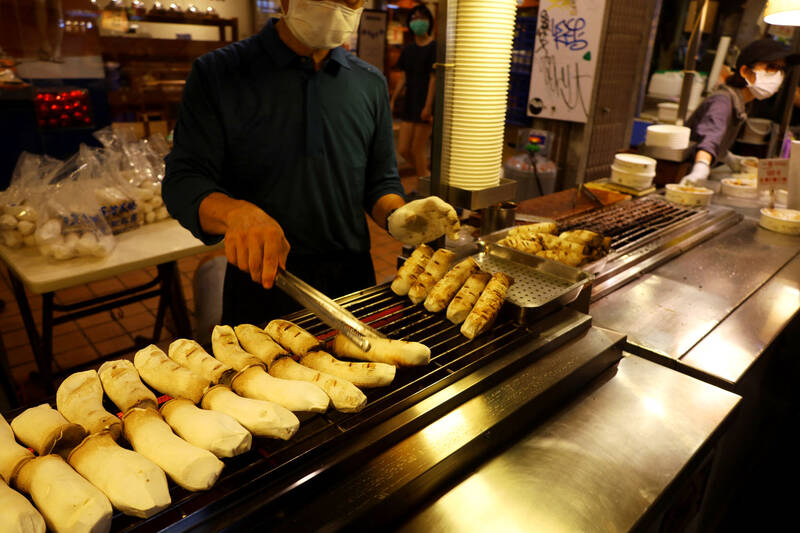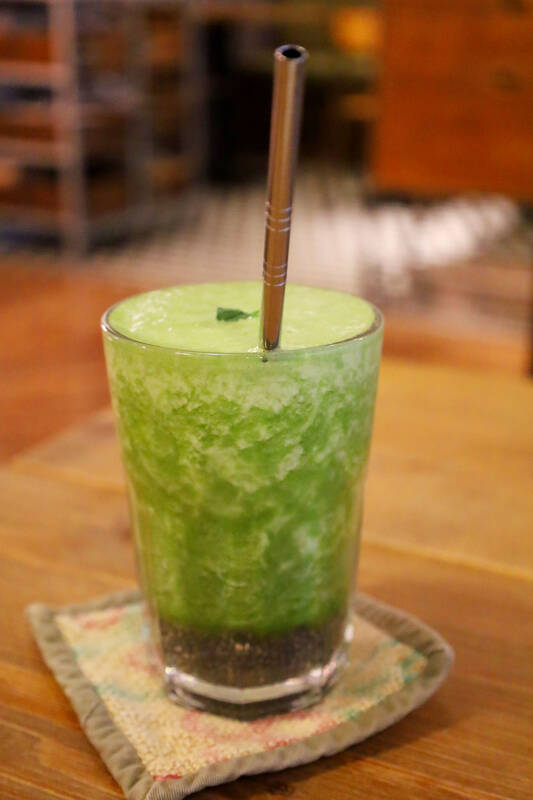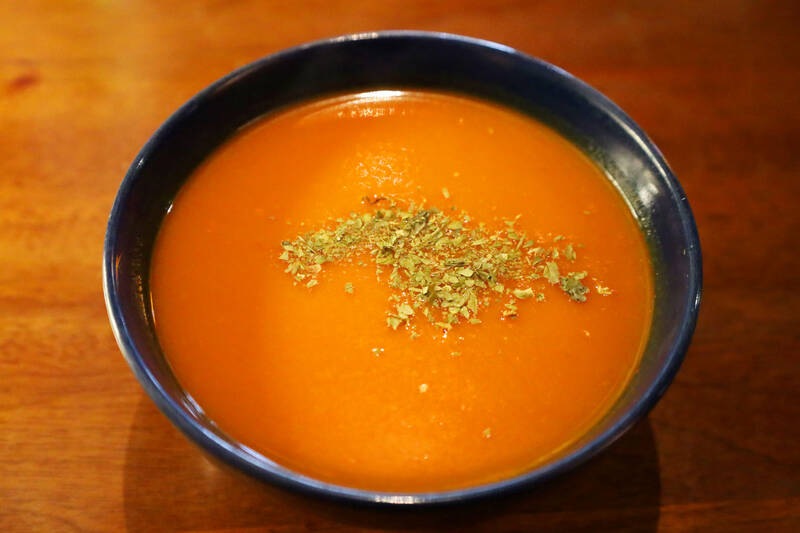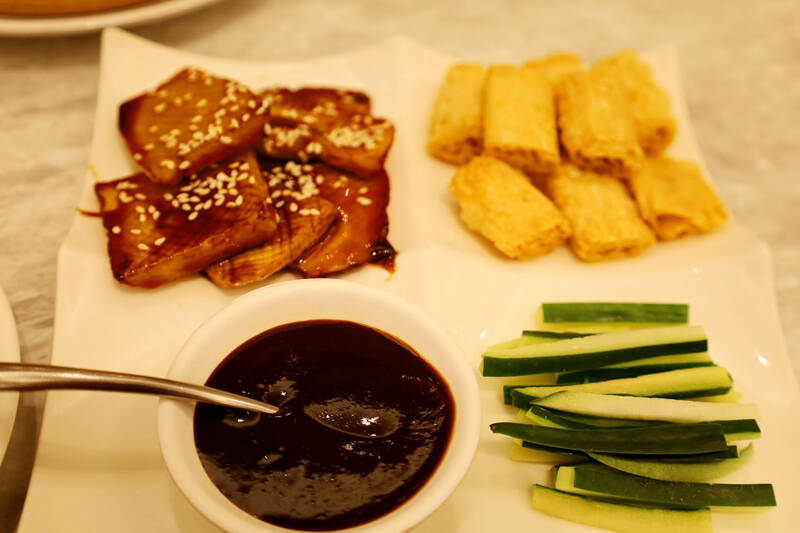The seeds of a modern vegetarian lifestyle were sown amid the transformative counterculture movement of the 1970s. Fifty-years on, the consensus that a meat-free diet is not just ethical and healthy but better for the planet (meat production accounts for between 15 and 20 percent of global emissions) has normalized pant-based living across much of North America, Europe and beyond.
This culinary wave has carried with it new terminology, ovo-vegetarian, lacto-ovo vegetarian, vegan and flexitarian. Wherever you find yourself on the foodie spectrum, Taiwan can seem like a pretty daunting place. Celebrated dishes like beef noodles (牛肉麵), Taiwanese-style fried chicken (鹹酥雞) and braised pork rice (滷肉飯) don’t exactly wave the green flag at newcomers.
Internationally too, the menu can appear limited. The Japanese period (1895-1945) has left a strong cultural imprint, evidenced in sushi bars on every second street, while American food made serious inroads in the post-war USAID-era introducing wheat and processed meats like hot dogs to the Formosan diet.

Photo: Thomas Bird, Taipei Times
A BRIEF HISTORY OF TAIWANESE VEGETARIANISM
In reality, vegetarian diets were commonplace in East Asia a thousand years before Linda McCartney managed to make a mass-market sausage out of some soybeans.
It was during the Song Dynasty (960-1279) that chefs first began making delectable meat alternatives out of mushrooms, beans and root vegetables. The vegetarian eating culture had its roots in religion, the Mahayana Dharmic concept of ahimsa (nonviolence), an “Eastern philosophy” that would inspire Californians to invent “hippie food” centuries later.

Photo: Thomas Bird, Taipei Times
Some Chinese became vegetarian in order to improve their karma; others became flexitarians in order to observe important dates like the 1st and 15th days of the lunar calendar, Lunar New Year’s eve and ancestral holy days. Others still would practice vegetarianism to pay penance or while mourning a loved one after a bereavement. Zen monks would make veganism integral to their religious practice.
Over subsequent centuries, Han migration to Taiwan brought with it Buddhist traditions, manifest in the temples that festoon the island as well as colorful pageantry that accompanies auspicious dates of the Buddhist calendar.
After the Chinese civil war ended in 1949, Buddhism fell under the boot of communism across the strait. In Taiwan, the faith survived political turmoil to flourish. Buddhism’s popularity has, indeed, risen in concert with economic and social progress — a phenomenon that has been dubbed “democracy’s dharma.”

Photo: Thomas Bird, Taipei Times
Today, the government estimates that 13 percent of Taiwan’s population is now vegetarian, around three million people, making Formosa the second highest per capita population of human herbivores anywhere in the world.
NAVIGATING THE VEGGIE-SCAPE
There are more vegetarian restaurants in Taiwan than you could possibly hope to visit unless you plan on eating out for the next four and a half years (the Happy Cow Web site currently lists 472 veggie-friendly establishments in Taipei, and 1,656 nationwide).

Photo: Thomas Bird, Taipei Times
Taiwanese vegetarian restaurants are not just numerous but diverse and can take the form of a meatless steamed-bun stall or a hipster health food store in a trendy mall.
The food can be equally eclectic, as Taiwan Tourism’s Web site poetically puts it: “Taiwan’s tropical-to-temperate climate profile and undulating topography support a diverse agriculture. The country’s many small farms shorten farm-to-table distances, encouraging chefs to create menus that capture the true character and taste of their regions.”
Simply put, diners can anticipate regional delicacies, from bitter gourd to water bamboo to lotus seeds, dished-up in even the humblest of eateries. Conversely, you’re unlikely to encounter strong flavors due to the traditional avoidance of the five pungent roots (五辛), which include onions, chives, garlic, green onions and leeks. Alcohol might also be exempt from the menu in some Buddhist restaurants, although Western-style vegan restaurants don’t to tend to abide by religious dogma.
The most commonplace meat-free eatery in Taiwan are the vegetarian buffet restaurants like Vegetable Foods (陽光健康素食) in Neihu District (內湖). These kind of restaurants lay out a buffet-style spread of tofu and vegetable dishes. Simply grab some tongs, fill up your takeaway box or cover your plate then pay by the weight (the price shouldn’t exceed NT$130). You might be asked if you want to add rice (white rice, five grain rice or purple rice) and broth is often complimentary. Remember, it pays to dine early, before the best dishes are devoured and the food turns cold.
Another good money-saving option is to frequent one of Taiwan’s celebrated night markets. While these bustling boroughs might be scented with aroma of sizzling squid, there’s plenty to satisfy a hungry herbivore. In Shihlin Night Market (士林夜市), Taipei’s largest, a long line forms each night outside Barbecued King Oyster Mushrooms (燒烤杏鮑菇) with customers eager to snack on nutritional fungi marinated in a choice of flavors. The market also has barbequed corn stalls and cold noodle vendors that advertise vegetarian-options on request.
Classic Dim Sum needn’t be a meaty affair. Yang Shin Vegetarian Restaurant (養心茶樓蔬食飲茶) located on the second floor above a bakery in Zhongshan District (中山) is said to be Taipei’s first, as well as its most authentic, vegetarian dim sum restaurant. Hand-rolled deep-fried pumpkin (NT$85), Shanghai soup dumpling made with vegan pork (NT$108) and Peking-style duck made with mushrooms (NT$330) are just some of sumptuous classics on the menu. The restaurant is also promoting its own range of veggie “fortune” zongzi (sticky rice dumplings) ahead of Dragon Boat Festival, which will be held on June 10. Just be aware that dim sum is best consumed in the company of friends.
The cool crowd heads to Plants, which offers customers a plant-based dining experience that is more in tune with restaurants in the West. The place has the airy vibe of a hip coffee shop and hums to an alt-rock soundtrack. In addition to energy bowls (NT$220-360), fruit smoothies (NT$200-250) and the best lentil falafel plate (NT$390) east of Cairo, this “wholesome eatery” also vends vegan cookbooks, organic milk and cheese alternatives, even alcohol-free wine “for those who are driving” apparently.
Located on the second floor of the downtown department store Shin Kong Mitsukoshi Xinyi Place A4 (新光三越 台北信義新天地A4) you’ll find the swankiest restaurant on our list. Herbivore (Herbivore A4信義店 Vegan料理) is where the white-collar crowd gather to talk shop over beans and greens. Tellingly, you can expect to pay between NT$400–NT$600 per person, although the dining experience is very much worth it. There’s an open kitchen where you can watch chefs work their vegan magic, a digital menu from where customers order fine wines (NT$240 per glass) and signature dishes like roasted cauliflower with vegan creme fraiche dip and vegan donuts (NT$395) via a smartphone. Additionally, there’s a solid range of coffees, teas and vegan pastries, should you be looking to entertain someone between meal times.
Fusion veggie dining is best experienced at Red Room Rendezvous (紅房餐酒館), a vegan restaurant at the heart of Daan District (大安) that blends “Western, Taiwanese and Mediterranean” plant-based cooking. Dishes like the vegan voodoo platter (NT$380) and the kimchi rainbow roll (NT$200) are really inventive, while soups and veggie burgers have a good old homecooked flavor. Red Room Rendezvous also houses a gallery, event space and bar, with some choice craft beers on tap and bar stools where solo diners can perch themselves, making it a more casual affair than other upscale vegan eateries.

This is a deeply unsettling period in Taiwan. Uncertainties are everywhere while everyone waits for a small army of other shoes to drop on nearly every front. During challenging times, interesting political changes can happen, yet all three major political parties are beset with scandals, strife and self-inflicted wounds. As the ruling party, the Democratic Progressive Party (DPP) is held accountable for not only the challenges to the party, but also the nation. Taiwan is geopolitically and economically under threat. Domestically, the administration is under siege by the opposition-controlled legislature and growing discontent with what opponents characterize as arrogant, autocratic

June 16 to June 22 The following flyer appeared on the streets of Hsinchu on June 12, 1895: “Taipei has already fallen to the Japanese barbarians, who have brought great misery to our land and people. We heard that the Japanese occupiers will tax our gardens, our houses, our bodies, and even our chickens, dogs, cows and pigs. They wear their hair wild, carve their teeth, tattoo their foreheads, wear strange clothes and speak a strange language. How can we be ruled by such people?” Posted by civilian militia leader Wu Tang-hsing (吳湯興), it was a call to arms to retake

When Lisa, 20, laces into her ultra-high heels for her shift at a strip club in Ukraine’s Kharkiv, she knows that aside from dancing, she will have to comfort traumatized soldiers. Since Russia’s 2022 invasion, exhausted troops are the main clientele of the Flash Dancers club in the center of the northeastern city, just 20 kilometers from Russian forces. For some customers, it provides an “escape” from the war, said Valerya Zavatska — a 25-year-old law graduate who runs the club with her mother, an ex-dancer. But many are not there just for the show. They “want to talk about what hurts,” she

It was just before 6am on a sunny November morning and I could hardly contain my excitement as I arrived at the wharf where I would catch the boat to one of Penghu’s most difficult-to-access islands, a trip that had been on my list for nearly a decade. Little did I know, my dream would soon be crushed. Unsure about which boat was heading to Huayu (花嶼), I found someone who appeared to be a local and asked if this was the right place to wait. “Oh, the boat to Huayu’s been canceled today,” she told me. I couldn’t believe my ears. Surely,